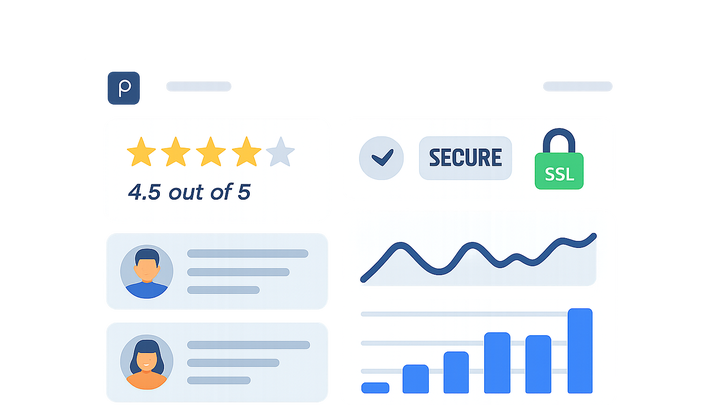Published on 2025-06-29T19:39:28Z
What are Trust Metrics? Examples of Trust Metrics
Trust Metrics are quantitative and qualitative indicators that measure the credibility, reliability, and user confidence in a website. They encompass factors such as:
- Social Proof: User reviews, testimonials, star ratings.
- Security Signals: SSL certificates, trust seals, privacy policies.
- Performance Reliability: Uptime, load times, mobile responsiveness.
- Accessibility Compliance: Adherence to WCAG standards.
In the contexts of CRO, UX, and SEO, trust metrics guide optimizations that enhance conversion rates, improve user satisfaction, and boost search rankings. SaaS tools like Prevue.me can scan your site for these critical signals, offering actionable critiques on lead generation forms, security implementations, and accessibility barriers. By monitoring and improving trust metrics over time, businesses can foster stronger customer relationships, reduce bounce rates, and drive sustainable growth.
Trust metrics
Quantitative and qualitative signals like reviews, badges, and performance metrics that build website credibility.
Why Trust Metrics Matter
Understanding the importance of trust metrics helps you see how credibility influences conversions, engagement, and SEO performance.
-
Boosting conversion rates
Websites that demonstrate trustworthiness tend to convert visitors into customers more effectively by reducing hesitation and skepticism.
- Reduced cart abandonment:
Visible security badges reassure users during checkout.
- Higher form submissions:
Social proof on lead capture forms increases sign-ups.
- Reduced cart abandonment:
-
Enhancing user experience
Trust signals like clear privacy policies and accessible design foster a positive browsing experience, encouraging users to stay longer.
- Clear privacy notices:
Inform users about data handling practices to build confidence.
- Accessibility compliance:
Meeting WCAG standards improves usability for all visitors.
- Clear privacy notices:
-
Improving seo and rankings
Search engines favor secure, reliable, and user-friendly websites, so strong trust metrics can indirectly boost rankings.
- Https and ssl:
Secure sites are prioritized in SERPs.
- Low bounce rate:
Engaging, credible sites keep users on the page longer.
- Https and ssl:
Key Types of Trust Metrics
Different categories of trust metrics help you assess various aspects of credibility on your website.
-
Social proof metrics
Measures based on user-generated content that demonstrates popularity and satisfaction.
- Customer reviews:
Aggregated ratings and testimonials.
- Social media mentions:
Shares, likes, and comments as indicators of brand trust.
- Customer reviews:
-
Security and privacy metrics
Signals that indicate safe handling of user data and secure website interaction.
- Ssl certificates:
Encrypted connections (HTTPS) to protect data in transit.
- Privacy policies:
Transparent statements on data collection and usage.
- Ssl certificates:
-
Performance and reliability metrics
Technical factors that ensure the site works smoothly and consistently.
- Uptime score:
Percentage of time the site is available without downtime.
- Load time:
Speed at which pages fully load for users.
- Uptime score:
Measuring Trust Metrics with Prevue.me
prevue.me offers a suite of automated critiques to help you identify and improve key trust metrics on your site.
-
Lead generation score
Analyzes forms and CTAs for usability and conversion friction, then scores based on best practices.
- Form field optimization:
Checks for overly complex forms hindering lead capture.
- Cta clarity:
Evaluates call-to-action button visibility and wording.
- Form field optimization:
-
Trust badge analysis
Scans for presence and correct placement of security seals and third-party certifications.
- Ssl seal verification:
Ensures valid encryption badges are displayed.
- Certification logos:
Checks for authentic logos from authorities like BBB or TRUSTe.
- Ssl seal verification:
-
Accessibility & ux critiques
Provides insights into compliance with accessibility standards and overall user experience hurdles.
- Wcag compliance checks:
Highlights violations in contrast, keyboard navigation, and ARIA labels.
- Navigation flow:
Assesses logical structure and ease of finding information.
- Wcag compliance checks:
Best Practices to Improve Trust Metrics
Actionable steps to enhance your website’s credibility signals.
-
Show real customer reviews
Encourage verified feedback and display ratings prominently.
- Verified testimonials:
Use tools to confirm review authenticity.
- Rich snippets:
Implement schema markup to display star ratings in search results.
- Verified testimonials:
-
Implement security seals
Place trusted badges in high-visibility areas to reassure visitors.
- Add ssl seal code:
Insert the following snippet:
<div class=\"trust-badge\"> <img src=\"https://example.com/ssl-seal.png\" alt=\"Secure Site\" /> </div> - Certificate renewal:
Regularly update and renew security certificates.
- Add ssl seal code:
-
Optimize site performance
Ensure fast, reliable access to bolster user confidence.
- Image compression:
Reduce file sizes for faster load times.
- Lazy loading:
Defer offscreen images to improve initial render speed.
- Image compression:
